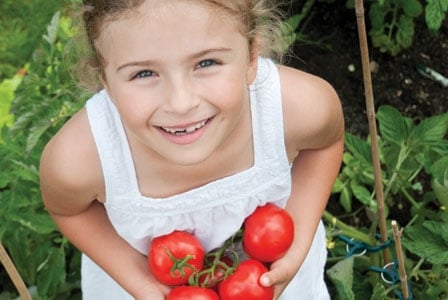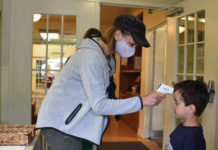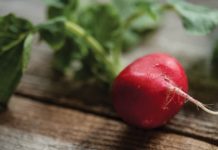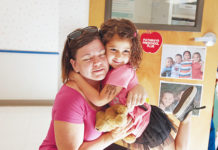
Evidence is clear about the importance of healthy food choices in schools. Now many provinces have new school nutrition programs that teach good food choices.
The Dieticians of Canada professional association states that “modelling healthy food habits at school and in childcare settings, and teaching children how to plan, shop, and prepare healthy foods can affect lifelong eating habits.” But what are Canadian schools doing to make this statement a reality? A lot, actually.
Several provinces, school districts, and individual schools have stepped up to the lunch plate, bringing healthy foods to growing children and the much publicized “food revolution” to Canada.
Importance of healthy food choices in schools
Evidence is clear and overwhelming about the importance of promoting healthy food choices in schools.
The 2010 provincial report, Guidelines for Food and Beverage Sales in BC Schools, notes that “children with healthy diets have improved brain development and mental abilities, increased self esteem, reduced anxiety, and less depression and hyperactivity.” The report emphasizes that “schools provide the ideal setting to enable children and youth to make healthy eating choices that support the realization of their individual potential.”
Similarly, a recent memorandum to the Ontario Ministry of Education’s School Food and Beverage Policy quotes a 2009 article from The Milbank Quarterly, which states that “health and education success are intertwined: schools cannot achieve their primary mission of education if students are not healthy.”
The experts have weighed in, and many Canadian schools are taking note, making groundbreaking changes toward healthier food options for students and school staff.
BC schools take lunch seriously
It’s early on a Tuesday morning. The halls of Metro Vancouver’s South Delta Secondary School are buzzing with the sights and sounds of students checking their lockers and texting friends as they hurry to their next class. Above the activity, the sweet smell of curry drifts through the hallways. It’s a signal that the culinary arts students have begun the day’s cafeteria meal preparation.
French fries, chicken nuggets, burgers, hot dogs—traditional fast-food lunch fare is rare on this school’s menu. Students are more likely to be treated to delectable dishes such as curried portobello mushrooms with basmati rice, wild salmon burgers, quinoa salad, or vegetarian chili.
South Delta Secondary School, with about 1,200 students, has a culinary arts program led by instructor Gerald Worobetz. Students actively participate in hands-on experiential learning as they work and eat in the school’s cafeteria—under the leadership of their chef instructor and support staff. This food program model is likely the envy of many a student, parent, and educator.
“Gone are the days of hot dogs, burgers, and french fries,” says Worobetz. “The fryer in this school is rarely used. We focus on fresh, seasonal, healthy choices. Our menus aim to get rid of all that starchy stuff and go a lot lighter. We use tons of fresh vegetables, including lettuce, celery, tomatoes, peppers, and cucumbers.”
Students design healthy menus
Five culinary arts classes, with students from grades 10 through 12, take a major role in operating this school’s cafeteria, helping to plan the week’s menus.
“Usually on Mondays,” says Worobetz, “we have a class discussion about what’s fresh, what’s out there, what vegetables are available at this time of year-—to try and get students in tune with menu preparation and where food comes from. Students sign up to take on various duties related to each day’s meal preparation.”
Students take it outdoors
Each fall, at the beginning of the school term, Worobetz takes his students to an outdoor location, such as a blackberry patch. “We freeze them and use them all winter in homemade blackberry muffins and sauces,”
says Worobetz.
The field trip is an opportunity for staff and students to get to know each other in the new school year. The conversations are often centred on where food fits into each student’s family and various other cooking topics.
Worobetz particularly remembers one interaction a number of years ago when a grade 10 student on the berry field trip was convinced that potatoes grew on trees. “That was a turning point for me,” explains Worobetz. “If students think potatoes grow on trees, they’ve really lost touch with where their food comes from. A lot of families today don’t garden and have lost that food connection. This program is trying to put them back in step. We also bring in as many raw ingredients as we can, to have the kids peel and chop them, rather than us buying pre-peeled vegetables.”
The kids weigh in
Student reaction to the healthier menus has been very positive. James in grade 10 and Brody in grade 11, both students in the culinary arts program, beam as they chop tomatoes and peppers for the day’s special, Thai salad. They express their enjoyment of the new food and remark that they don’t even miss those “greasy fries.” Jaden in grade 8, seated with his friends in the cafeteria at lunchtime, explains that his favourite school foods are the salmon burgers and barbecue wraps.
Ontario schools join the food revolution
Other provinces are also making changes by implementing healthier school food policies. In Ontario, for example, the Peel District School Board—with more than 150,000 students in 233 schools in Brampton, Caledon, and Mississauga—has enthusiastically embraced new food policies.
As part of an innovative School Food Action Coalition, (facilitated by the environmental organization EcoSource), the Peel District School Board, Chartwells (the primary foodservice provider for many Peel schools), and Peel Public Health formed a partnership to increase student awareness and engagement in local food choices in their cafeterias. Their work included introduction of new, local food ingredients and menu options, and campaigns for students to participate directly in food changes coming to their cafeterias.
“I think one of our most productive initiatives has been a focus on student engagement,” says Leo Kazlovskis, Peel School food and beverage coordinator. “Recently we met with over 150 student council presidents and executive members to review the new Food and Beverage Policy and to explain what changes they could expect to see in their high school cafeterias in September as a result of the new nutrition standards. Each student was given a communications package to take back to their school to begin the discussion process of why changes were happening. The students get it; they see the rationale and were eager to support the healthy living aspects of the new policy.”
Secondary students in the Peel District even created their own meal option featuring healthy, local Ontario foods as part of the Cooking Up Action! menu challenge. The winner of the challenge was Gourmet Society 2 of Applewood Heights Secondary School. Its winning menu included an Ontario butternut squash soup and an entree of local cauliflower mash and herbed Ontario chicken. Gourmet Society 2 won $1,000 and a visit to a local farm. Its dish will be served in Peel District School Board cafeterias in the fall of 2011.
“Students want to be directly involved in the food choices in their cafeterias,” says Lea Ann Mallett, executive director of EcoSource, with the Peel School Food Action Coalition. “If we give students a chance to taste Ontario foods and create their own local food menu items, they will be more empowered to choose to eat them.”
Students plant and harvest food
Students are also planting and harvesting their own food for school cafeteria programs. Unique edible schoolyard gardens are sprouting up across the country with innovative solutions to limited space or challenging summer garden maintenance.
Rooftops, greenhouses, school garden beds, parks, and even windowsill gardens are showing that ?creativity and ingenuity can be used to help feed the food revolution.
Stratford Northwestern Secondary School in Stratford, Ontario, under the culinary leadership of Paul Finkelstein, culinary arts instructor, operates an internationally recognized high school culinary arts program that educates over 200 students per year, and has grown to include a large kitchen classroom, a 3,000-square-foot organic garden and greenhouse, a six-acre school farm, and outreach programs to elementary students.
Their hip and funky cafeteria, the Screaming Avocado Café, offers healthy, delicious, gourmet lunches to students and staff by using locally sourced ingredients from its own Seeds of Change Garden and Mud to Mouth Farm. The program also uses social media technology to communicate with fellow students and the community about recent food and culinary discoveries.
“We include students in all aspects of what we do,” says Finkelstein. “The kids plant, weed, harvest, and prepare the yield into incredible recipes.”
Alison Farbar, from the Peel District School Board, also reports: “West Credit Secondary School in Mississauga runs its own cafeteria, grows produce in its greenhouse to serve to students, while maintaining an outdoor garden through partnerships in the community.”
West Coast schools get growing
In cool climates school gardening can be challenging. Students in the Enviro Club at North Peace Secondary School in Fort St. John, BC, met the challenge. With teachers’ help, students successfully grew salad greens and herbs in their rooftop greenhouse to supply their school cafeteria’s salad bar and some local elementary schools.
In Maple Ridge, BC, Blue Mountain Elementary School oversees 36 garden beds, of which several are shared with a neighbouring high school culinary department, a daycare, and various other neighbours. Each class tends to two garden beds while practising a philosophy they call “Seed to Plate,” whereby students plant, nurture, harvest, cook, and eat their garden produce.
Partnerships with parents and a nearby women’s correctional centre also helps keep ongoing garden maintenance under control. For elementary and junior high schools without culinary departments or large gardens, partnerships with high schools and community gardens are an excellent solution.
South Delta Secondary, working with the Earthwise Society community gardens, tended three garden plots on the Earthwise site and grew vegetables and herbs. When year-round off-site plot maintenance became too much work for the school, they scaledback to smaller plots on school grounds to concentrate on herbs such as rosemary, parsley, and basil. Instructor Worobetz is excited by the recent addition of three honeybee hives to the school site—in anticipation of fresh honey for use in cafeteria cooking.
Located in the fertile Fraser River delta with a mild climate, South Delta Secondary is fortunate to be close to many farms and greenhouse vegetable producers. Worobetz and his team have created positive relationships with local food producers resulting in considerable food donations, which help to sustain reasonable cafeteria prices of $2 to $4 per main menu item.
The often-repeated motto, “feed the body, feed the brain” now appears to be taking hold in Canadian schools. Whether it’s called a food revolution or a renaissance, it seems clear that school food will never taste the same again.
Healthy lunches—delivered!
Moms across the country are starting their own food revolutions, preparing and delivering healthy individual lunches to children at school for a reasonable fee. For busy parents who may not have the time to assemble balanced lunches for their children, these lunch delivery services are the perfect solution. Below are two mom-started companies paving the revolutionary road.
Good Bite Lunch Company
Serving the Cowichan and Chemainus Valley areas of BC, Good Bite Lunch Company delivers fresh, nutritious, kid-approved lunches to children daily. Good Bite promises to use organic and local ingredients whenever possible, follows environmentally responsible practices, and gives back to participating schools. Parents even have the option to purchase a gift lunch through Good Bite, which will be donated to a child who may not have access to whole, healthy foods. goodbitelunch.com
Credible Edibles
This Ottawa-based lunch delivery service operates with three key criteria in mind: taste, nutrition, and environmental impact. Credible Edibles promises a minimum of three servings of fruits and vegetables in every child’s lunch and relies heavily on 12 nutritionally rich ingredients: beans, berries, broccoli, citrus fruits, flax, nuts, wild salmon, soy, spinach, tea, tomatoes, and whole grains. credible-edibles.ca
Steps to creating a successful school food program
1. Establish a school food and/or garden committee with parents, students, teachers, and community partners.
2. Get approval and involvement from the principal, school board, and/or food service provider.
3. Research and visit other schools to see their projects.
4. Access online resources such as healthyeatingatschool.ca, ecosource.ca, evergreen.ca, and screamingavocado.webs.com.
5. Read the document “10 ways your SAC [Students] can prepare students for healthy changes” at peelschools.org/student/foodandbevSAC.htm.
6. Develop a collective vision and policies for the food and/or garden program.
7. Establish an ongoing maintenance strategy.
8. Organize some fun celebratory events to acknowledge success.
9. Evaluate and revise over the years, while being flexible, because one formula doesn’t fit all schools.





























